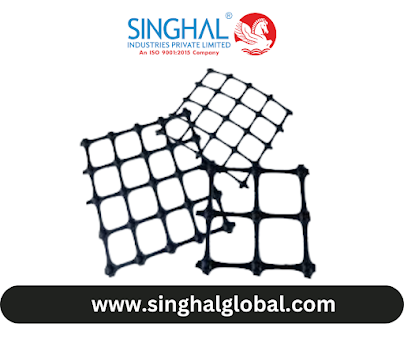A Comprehensive Guide to Installing HDPE Pond Liners
- Get link
- X
- Other Apps
High-Density Polyethylene (HDPE) pond liners are a popular choice for creating durable, leak-proof ponds in gardens, agricultural setups, and industrial sites. This guide will take you through the essential steps for installing HDPE pond liners, ensuring that your pond remains sturdy and long-lasting. Additionally, we will address common questions and considerations such as the role of an HDPE pond liner manufacturer, the significance of the 500-micron thickness, and factors affecting the HDPE Pond Liner price.
Why Choose HDPE Pond Liners?
HDPE pond liners are preferred due to their excellent resistance to UV radiation, chemicals, and punctures. They are flexible yet tough, making them suitable for various types of ponds, including fish ponds, water gardens, and large agricultural or industrial water containment areas.
One of the leading manufacturers in this field is Singhal Industries, known for producing high-quality HDPE liners that meet international standards.
Step-by-Step Guide to Installing HDPE Pond Liners
Planning and Design
Before you start digging, spend some time planning the design of your pond. Consider the pond's purpose, size, shape, and depth. This will help determine the amount of HDPE liner you'll need. You can create a sketch or use pond design software to visualize the final product.
Excavation
Once your design is ready, it's time to start digging. Mark the outline of your pond on the ground using stakes and string. Begin excavation, ensuring the sides slope gently to prevent soil erosion and liner damage. The depth should be consistent with your plan, with an additional allowance for underlayment and the liner.
Smoothing and Levelling
After excavation, smooth the pond bottom and sides to remove any sharp objects, rocks, or roots that could puncture the liner. Ensure the surface is as even as possible to prevent any strain on the liner once it’s in place.
Installing the Underlayment
Before laying the HDPE liner, install an underlayment to provide an extra layer of protection. The underlayment, which can be made of geotextile fabric or old carpet material, helps shield the liner from punctures and abrasions caused by rocks and roots.
Positioning the HDPE Pond Liner
Carefully unfold and spread the HDPE liner over the pond area. HDPE liners are available in various thicknesses, with Hdpe Pond Liner 500 Micron being a common choice for added durability. Ensure the liner extends beyond the pond edges by at least 12 inches to secure it in place.
Securing the Liner
To secure the liner, place heavy rocks or weights along the edges. This temporary measure will hold the liner in place as you begin to fill the pond with water. Make sure the liner conforms to the pond's contours and is free from wrinkles and folds.
Filling the Pond
Begin filling the pond with water gradually. As the water level rises, adjust the liner to ensure it remains smooth and fits snugly against the pond’s sides and bottom. The weight of the water will help push the liner into place, removing any remaining wrinkles.
Trimming and Final Securing
Once the pond is filled and the liner is settled, trim any excess liner material, leaving enough to secure it around the edges. Bury the liner edges in a trench around the pond’s perimeter and cover it with soil or rocks to keep it in place and give a neat appearance. Adding Finishing Touches
Finally, add your chosen aquatic plants, fish, and other features to complete your pond. Ensure that any decorative elements do not damage the liner.
Conclusion
Installing an HDPE pond liner is a manageable task that can transform your landscape, providing a beautiful and functional water feature. By choosing a reputable HDPE Pond Liner Manufacturer like Singhal Industries and following the steps outlined in this guide, you can ensure a successful installation that will last for years.
Whether you are looking for a 500-micron HDPE pond liner or want to understand the factors affecting the HDPE pond liner price, this guide has you covered. With careful planning and execution, your pond will become a cherished addition to your property.
FAQs
What is the best thickness for an HDPE pond liner?
The thickness of an HDPE pond liner depends on the pond’s purpose and size. A 500-micron HDPE liner is a popular choice for most applications due to its balance of flexibility and durability.
How do I determine the HDPE pond liner price?
The price of an HDPE pond liner is influenced by factors such as thickness, area, and the manufacturer. Singhal Industries offers competitive pricing for high-quality liners. It's best to request a quote based on your specific requirements.
How long do HDPE pond liners last?
HDPE pond liners are known for their longevity, often lasting 20 years or more with proper installation and maintenance. Their resistance to UV rays and chemicals contributes to their durability.
Can I install an HDPE pond liner myself?
Yes, with proper planning and attention to detail, you can install an HDPE pond liner yourself. Follow the step-by-step guide above, and ensure you have the necessary tools and materials before starting.
What maintenance is required for an HDPE pond liner?
HDPE pond liners require minimal maintenance. Regularly check for and remove debris, ensure plants do not damage the liner, and monitor for any signs of wear or punctures.
- Get link
- X
- Other Apps
.jpg)

.png)
Comments
Post a Comment